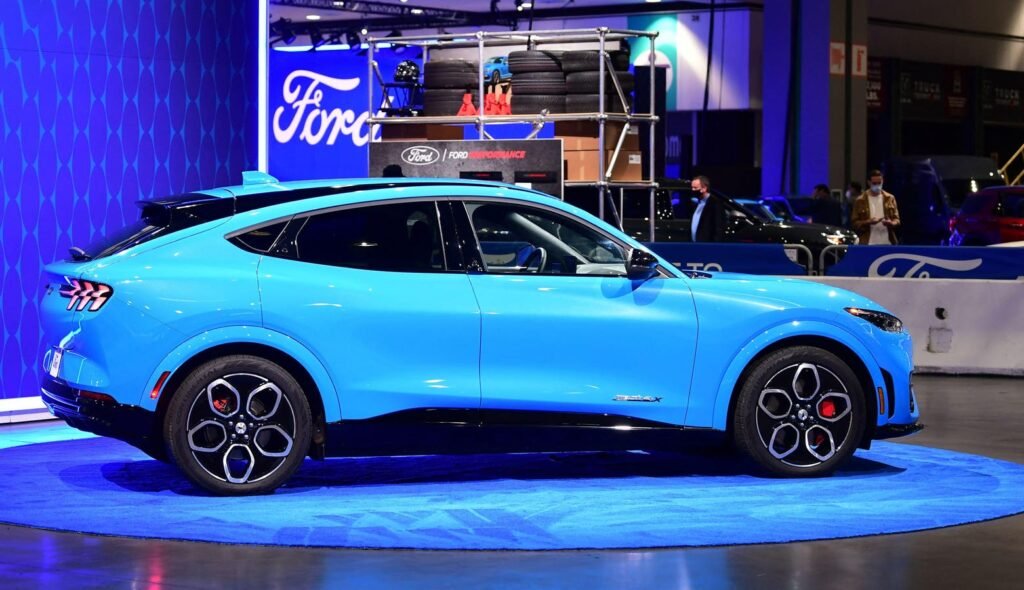The fully electric Ford Mustang Mach-E GT SUV is displayed at the Los Angeles Auto Show in Los Angeles, California, on November 18, 2021. (Photo: Frederick J. Brown/AFP) (Photo: Frederick J. Brown/AFP via Getty Images)
AFP via Getty Images
Not only is the 2024 Mustang Mach-E GT incredibly fast, it also comes equipped with a surprising feature: Ford’s Blue Cruise semi-autonomous driver-assistance technology.
Just for some background, I tend to focus on ADAS (Advanced Driver Assistance Systems) when test driving EVs. In this review, I will focus on the 2024 Mustang Mach-E GT ADAS. I just finished a test drive of the Mach-E in the Mojave Desert, where I was able to put BlueCruise to the test. (My recent testing also included General Motors’ Super Cruise Gen 2 and Tesla’s latest Full Self-Driving update.)
Bluecruise Part 1: Bluecruise is designed primarily as a hands-free driver assist technology on major highways. So in Los Angeles, on highways like the 5, 405, 118, 101, and 10 mapped by Bluecruise, the car will drive automatically even if you take your hands off the wheel. The adaptive cruise control will do the braking and acceleration, while BlueCruise will handle the steering. This worked very well on Interstate 5 and Interstate 14, handling most of the highway driving with the help of automatic lane changing.
Bluecruise Part 2: Heading north on Interstate 5 and Route 14 brings me to the Mojave Desert, where I had ample opportunity to test Bluecruise in its off-highway mode (see video below). Off-highway mode is important because it lets me trust BlueCruise to work on small, unmapped roads, such as the ruler-edge straight two-lane routes that crisscross the Mojave Desert. Essentially, this mode is lane-centering technology (similar to what’s offered in the Toyota Bz4x and Subaru Solterra that I tested). But it’s very good technology. This is the main difference between Bluecruise and General Motors’ Supercruise Gen 2. Supercruise Gen 2 offers a much larger map than Supercruise Gen 1, but it doesn’t offer lane-centering technology on the small roads where Supercruise doesn’t work. Think of lane-centering as an unmapped ADAS. The great thing about lane centering is that you can use it virtually anywhere.
Bottom line: We were very impressed with Bluecruise, which offers both mapped and non-mapped ADAS. Bluecruise is not a Tesla FSD, but it does offer advanced semi-autonomous driver assistance at a much lower price than FSD. Bluecruise comes with 3 months of free service, after which monthly fees are $75 compared to $199 for FSD.
Other things: (1) Speed: The Mach-E GT is incredibly fast, accelerating from 0 to 60 mph faster than the Lucid Air Pure I test drove a few months ago. (2) Range: It has a decent 270 mile range for a high-performance EV, and the CCS charging times are fast. (3) Another thing that surprised me is that this is a true SUV, not a sedan like the traditional Mustang, which means more interior space. (4) Finally, Ford is focusing on OTA updates, which means they’re focusing on improving Bluecruise, something that competing traditional automakers haven’t always been consistent with in their ADAS technology.
A Ford Mustang Mach-E GT in the Mojave Desert in Lancaster, California.
Credit: Brooke Crothers
Source link

